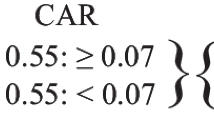Abstract
Background
Anastomotic leakage (AL) after rectosigmoid resection is a serious complication associated with high morbidity and mortality. This case–control pilot study investigated the changes in blood concentration of 10 different cytokines and 2 complement factors in relation to symptomatic AL after low anterior resection for rectosigmoid cancer.
Methods
Fifty patients scheduled for resection of rectosigmoid cancer had blood samples taken the day before surgery and on post-operative days 1, 3 and 5. Four patients with symptomatic AL were identified. Twenty-two age- and disease-matched patients constituted the control group. The concentration of 10 cytokines (granulocyte macrophage colony-stimulating factor, interferon-γ, interleukin-1β, interleukin-2, interleukin-4, interleukin-5, interleukin-6, interleukin-8, interleukin-10 and tumour necrosis factor-α) and 2 complement factors (mannan-binding lectin and membrane attack complex) were measured.
Results
The present study demonstrated that plasma concentration of interleukin-1β, interleukin-6, interleukin-8 and interleukin 10 within the first 5 post-operative days was increased in patients who developed early clinical AL, whereas there were no changes in patients with late-onset AL.
Conclusions
The demonstrated differences in the cytokine response in early and late AL may support the theory of different pathological mechanisms of AL.








Similar content being viewed by others
References
Sacchi M, Legge PD, Picozzi P et al (2007) Virtual ileostomy following TME and primary sphincter-saving reconstruction for rectal cancer. Hepatogastroenterology 54:1676–1678
Matthiessen P, Strand I, Jansson K et al (2007) Is early detection of anastomotic leakage possible by intraperitoneal microdialysis and intraperitoneal cytokines after anterior resection of the rectum for cancer? Dis Colon Rectum 50:1918–1927
Rullier E, Laurent C, Garrelon JL et al (1998) Risk factors for anastomotic leakage after resection of rectal cancer. Br J Surg 85:355–358
Nesbakken A, Nygaard K, Lunde OC (2001) Outcome and late functional results after anastomotic leakage following mesorectal excision for rectal cancer. Br J Surg 88:400–404
Law WL, Chu KW (2004) Anterior resection for rectal cancer with mesorectal excision: a prospective evaluation of 622 patients. Ann Surg 240:260–268
den Dulk M, Noter SL, Hendriks ER et al (2009) Improved diagnosis and treatment of anastomotic leakage after colorectal surgery. Eur J Surg Oncol 35:420–426
Matthiessen P, Henriksson M, Hallöök O et al (2007) Increase of serum c-reactive protein is an early indicator of subsequent symptomatic anastomotic leakage after anterior resection. Colorectal Dis 10:75–80
Platt JJ, Ramanathan ML, Crosbie RA et al (2012) C-reactive protein as a predictor of postoperative infective complications after curative resection in patients with colorectal cancer. Ann Surg Oncol 19:4168–4177
Rahbari NN, Weitz J, Hohenberger W et al (2010) Definition and grading of anastomotic leakage following anterior resection of the rectum: a proposal by the International Study Group of Rectal Cancer. Surgery 147:339–351
Haahr-Pedersen S, Bjerre M, Flyvbjerg A et al (2009) Level of complement activity predicts cardiac dysfunction after acute myocardial infarction treated with primary percutaneous coronary intervention. J Invasive Cardiol 21:13–19
Fouda E, Nakeeb AE, Magdy A et al (2011) Early detection of anastomotic leakage after elective low anterior resection. J Gastrointest Surg 15:137–144
Cruickshank AM, Fraser WD, Burns HJ et al (1990) Response of serum interleukin-6 in patients undergoing elective surgery of varying severity. Clin Sci 79:161–165
Pedersen ME, Qvist N, Bisgaard C et al (2009) Peritoneal microdialysis early diagnosis of anastomotic leakage after low anterior resection for rectosigmoid cancer. Scand J Surg 98:148–154
Wagner M, Zappa M, Maggiori L, Bretagnol F, Vilgrain V, Panis Y (2014) Can postoperative complications be predicted by a routine CT scan on day 5? A study of 78 laparoscopic colorectal resections. Tech Coloproctol 18:239–245
Conflict of interest
None.
Author information
Authors and Affiliations
Corresponding author
Rights and permissions
About this article
Cite this article
Ellebæk, M.B., Baatrup, G., Gjedsted, J. et al. Cytokine response in peripheral blood indicates different pathophysiological mechanisms behind anastomotic leakage after low anterior resection: a pilot study. Tech Coloproctol 18, 1067–1074 (2014). https://doi.org/10.1007/s10151-014-1204-2
Received:
Accepted:
Published:
Issue Date:
DOI: https://doi.org/10.1007/s10151-014-1204-2




